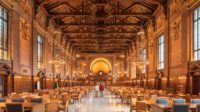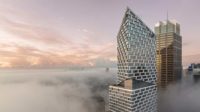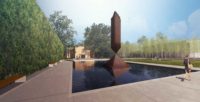The 1998 opening of Dominique Perrault’s Bibliothèque Nationale, with its four glazed towers anchoring Paris’s new eastward expansion, also generated a new episode in the life of the library’s former quarters on the Right Bank. That dense city block included 17th-century hôtels along with purpose-built 19th- and early 20th-century structures that had housed the library’s varied collections.
The crown jewel of this complex, bounded by the rue de Richelieu on one long side and rue Vivienne on the other, was the insertion into one of the site’s three open courtyards of a majestic reading room and adjacent iron book stacks (1860–68), all skylit, a masterwork of Henri Labrouste. With the transfer of millions of books and periodicals to Perrault’s library, these storied spaces were up for grabs.
Additional Content:
Jump to credits & specifications
Several government agencies came up with a solution that would retain the Bibliothèque Nationale’s unbound collections, such as coins, photographs, and maps, on the old Richelieu site and create a home for the newly formed National Art History Institute, an art library to be housed in Labrouste’s main reading room and stacks. In addition, the Ecole de Chartes, a school to train archivists and librarians, was given space in the renovated wings that Labrouste had turned into the site’s impressive perimeter wall.
The first phase of this complex operation was completed in January by architects Bruno Gaudin and Virginie Brégal (renovation) alongside Jean- François Lagneau (restoration). The effort will transform a site previously open only to advanced researchers and those with library cards into a permeable city quarter. Its projected completion in 2020 (with minimal visible alterations) will have more connections than the current single door on the rue de Richelieu, and allow views to the interior.
Most prominently, a second-floor glazed passageway, Gaudin and Brégal’s only completely new architectural piece in the assemblage—executed to meet stringent accessibility and fire codes— links the parts of this institutional puzzle with enormous clarity. It affords plunging views into Lagneau’s spectacular restoration of Labrouste’s lofty reading room.
Labrouste’s library combined two spaces—the serene reading room, with its nine ceramic light-reflecting domes held aloft on attenuated cast iron columns, and the cathedral-like stack room, with its central nave flanked by six stories of book stacks. The two are connected by a monumental glazed, arched portal flanked by giant caryatids, forming a great theatrical proscenium arrangement. Originally it was even outfitted with an enormous velvet curtain that blocked views of the stacks, where the pages retrieved books for readers at their desks in the main room.
Today, that backstage has been thrown open to readers, who enjoy unfettered access to the very stacks that Sigfried Giedion made famous in Space, Time and Architecture (1940), where he cast the open cage of iron-gridded floors as a forerunner of modernist space and skyscraper technology.
In the restoration of the reading room, Lagneau negotiated with the fire department to hide the modern infrastructure in order to maintain Labrouste’s “shadowless light”—ideal for reading, and filtered through polished glass oculi in the nine domes. Originally the room had no artificial illumination, so every aspect of the design was conceived to maximize available daylight, especially in the gray Parisian winter. Electric lamps were added at the readers’ desks when evening hours were instituted in the 1920s. These have been painstakingly restored, or replaced with replicas.
In addition, Lagneau paid close attention to the role played by the white and cream palette for the ceramic-tiled cupolas and to the gilded accents on the curved iron trusses. The uniform milk chocolate–brown paint of the lofty iron columns was removed, and the brown wall-to-wall carpet tiles replaced with light-reflective parquet. Lagneau’s recreation of the original pale color scheme in this great mosque for reading creates the effect of an aerie, notably in the subtle difference between the lighter gray shafts of the four attenuated columns at the center and the darker gray of the periphery columns.
Column capitals now are richly differentiated to suggest the variety of metals Labrouste brought together, and the canopies reveal themselves—as he intended—as assemblages of iron and aluminum, each legible by color. In his time, aluminum was a precious material just making a transition from luxury jewelry to lightweight construction. Like industrially manufactured thin ceramic tiles, it proved to be a greater novelty than the use of iron, which was already common for fireproofing in theater roofs and train sheds.
The farther Gaudin and Brégal worked away from the watchful eye of Lagneau—and particularly in spaces where Labrouste had been lost or seriously compromised—the more they developed their own vocabulary in wallcoverings, furniture, and lighting features. Some of the results will quickly be dated, like the curved screens of pale wood that give the long space of the new theater arts reading room an Aaltoesque rhythm, or the exuberant chandelier in the main entrance vestibule. In the second phase, the glazed link will connect the rue de Richelieu and rue Vivienne; the Salle Ovale, the monumental reading room designed in the late 19th century by Jean Louis Pascal, will be included in the restoration, along with other historic spaces. Controversy from preservationists has dogged the project over the years, notably in the proposed new sweeping stair to replace one by Pascal in the rue Vivienne vestibule. But despite these quibbles, the experience is glorious: to visit Labrouste’s library is now an invitation not only to read, but to reread Labrouste.
CreditsArchitect: Bruno Gaudin & Virginie Bregal architecte
Personnel in architect's firm who should receive special credit: Raphaële Lepetit, project manager, architecte dplg
Engineers Egis Batiments - structural fluids electricity : Régis Lelievre, Pauline Ratti, Thomas Jason Consultants L'observatoire 1 - lighting design : Georges Berne, Emmanuelle Sebie
Photographer: Meffre & Marchand, Takuji Shimmura, Atelier Bruno Gaudin
|
SpecificationsStructural System Manufacturer of any structural components unique to this project: Serrurerie Bernard, glass gallery steel structure + SGG Cool-lite SKN 154 glazing Roofing Metal: VMZINC, natural zinc, double lock standing seam Tile/shingles: ARDOISE D'ANGERS, Trélazé (slate) Glazing Glass: SGG, Noble EKO Doors Fire-control doors, security grilles: Fire-control door/ glazed partition : JANSEN Janisol C4 + VISS Fire Hardware Exit devices: BEHAR Sécurité Interior Finishes Acoustical ceilings: SONOGAMA, Baswa phon Cabinetwork and custom woodwork: BONNARDEL Resilient flooring: TARKET, linoleum Veneto FX Furnishings Other furniture: BRUYNZEEL, shelving & mobile storage system Conveyance Elevators/escalators: THYSSENKRUPP, elevator Energy Add any additional building components or special equipment that made a significant contribution to this project: Historical restauration of Salle Labrouste, Jean-François LAGNEAU architect. |
















Post a comment to this article
Report Abusive Comment